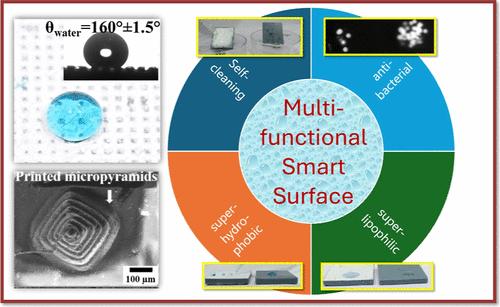ZnO纳米粒子修饰的增材制造技术制备多功能超疏水表面
IF 3.9
2区 化学
Q2 CHEMISTRY, MULTIDISCIPLINARY
引用次数: 0
摘要
本文报道了一种具有超疏水自清洁性能、超亲油性和抗菌性能的多功能智能表面的简单制备。这些智能表面是利用增材制造技术的立体光刻(SLA)方法合成的。SLA是一种快速增材制造技术,用于创建具有复杂几何形状的复杂零件。各种各样的材料和高分辨率技术可以用来制造功能部件,如超疏水表面。人们研究了各种材料来提高3D打印的功能。然而,这种材料的制造并不容易,因为它非常昂贵。在这项工作中,我们使用了市售的SLA打印机及其光聚合物树脂来创建各种微图案表面。此外,我们应用了具有ZnO纳米颗粒和正硅酸四乙酯的低表面能涂层来创建分层粗糙度。通过静态接触角和滚转角测量,对制备的超疏水表面的润湿性进行了评价。研究了不同涂层浓度、干燥温度、结构(金字塔、柱状结构和打蛋器结构)和柱状结构间距等因素对接触角的影响。随后,使用数据、图像和支持视频证明了所得表面的所有功能特性(即自清洁、亲油和抗菌特性)。这种廉价且可扩展的工艺可以用SLA 3D打印机和光聚合物树脂轻松复制,用于许多应用,如自清洁,油水分离,无通道微流体,抗菌涂层等。本文章由计算机程序翻译,如有差异,请以英文原文为准。

Facile Fabrication of Multifunctional Superhydrophobic Surfaces Synthesized by the Additive Manufacturing Technique Modified with ZnO Nanoparticles
This article reports facile fabrication of a multifunctional smart surface having superhydrophobic self-cleaning property, superoleophilicity, and antimicrobial property. These smart surfaces have been synthesized using the stereolithography (SLA) method of the additive manufacturing technique. SLA is a fast additive manufacturing technique used to create complex parts with intricate geometries. A wide variety of materials and high-resolution techniques can be utilized to create functional parts such as superhydrophobic surfaces. Various materials have been studied to improve the functionality of 3D printing. However, the fabrication of such materials is not easy, as it is quite expensive. In this work, we used a commercially available SLA printer and its photopolymer resin to create various micropatterned surfaces. Additionally, we applied a low surface energy coating with ZnO nanoparticles and tetraethyl orthosilicate to create hierarchical roughness. The wettability studies of created superhydrophobic surfaces were evaluated by means of static contact angle using the sessile drop method and rolling angle measurements. The effects of various factors, including different concentrations of coating mixture, drying temperatures, patterns (pyramids, pillars, and eggbeater structures), and pillar spacing, were studied in relation to contact angles. Subsequently, all the functional properties (i.e., self-cleaning, oleophilicity, and antibacterial properties) of the as-obtained surfaces were demonstrated using data, images, and supporting videos. This inexpensive and scalable process can be easily replicated with an SLA 3D printer and photopolymer resin for many applications such as self-cleaning, oil–water separation, channel-less microfluidics, antibacterial coating, etc.
求助全文
通过发布文献求助,成功后即可免费获取论文全文。
去求助
来源期刊

Langmuir
化学-材料科学:综合
CiteScore
6.50
自引率
10.30%
发文量
1464
审稿时长
2.1 months
期刊介绍:
Langmuir is an interdisciplinary journal publishing articles in the following subject categories:
Colloids: surfactants and self-assembly, dispersions, emulsions, foams
Interfaces: adsorption, reactions, films, forces
Biological Interfaces: biocolloids, biomolecular and biomimetic materials
Materials: nano- and mesostructured materials, polymers, gels, liquid crystals
Electrochemistry: interfacial charge transfer, charge transport, electrocatalysis, electrokinetic phenomena, bioelectrochemistry
Devices and Applications: sensors, fluidics, patterning, catalysis, photonic crystals
However, when high-impact, original work is submitted that does not fit within the above categories, decisions to accept or decline such papers will be based on one criteria: What Would Irving Do?
Langmuir ranks #2 in citations out of 136 journals in the category of Physical Chemistry with 113,157 total citations. The journal received an Impact Factor of 4.384*.
This journal is also indexed in the categories of Materials Science (ranked #1) and Multidisciplinary Chemistry (ranked #5).
 求助内容:
求助内容: 应助结果提醒方式:
应助结果提醒方式:


